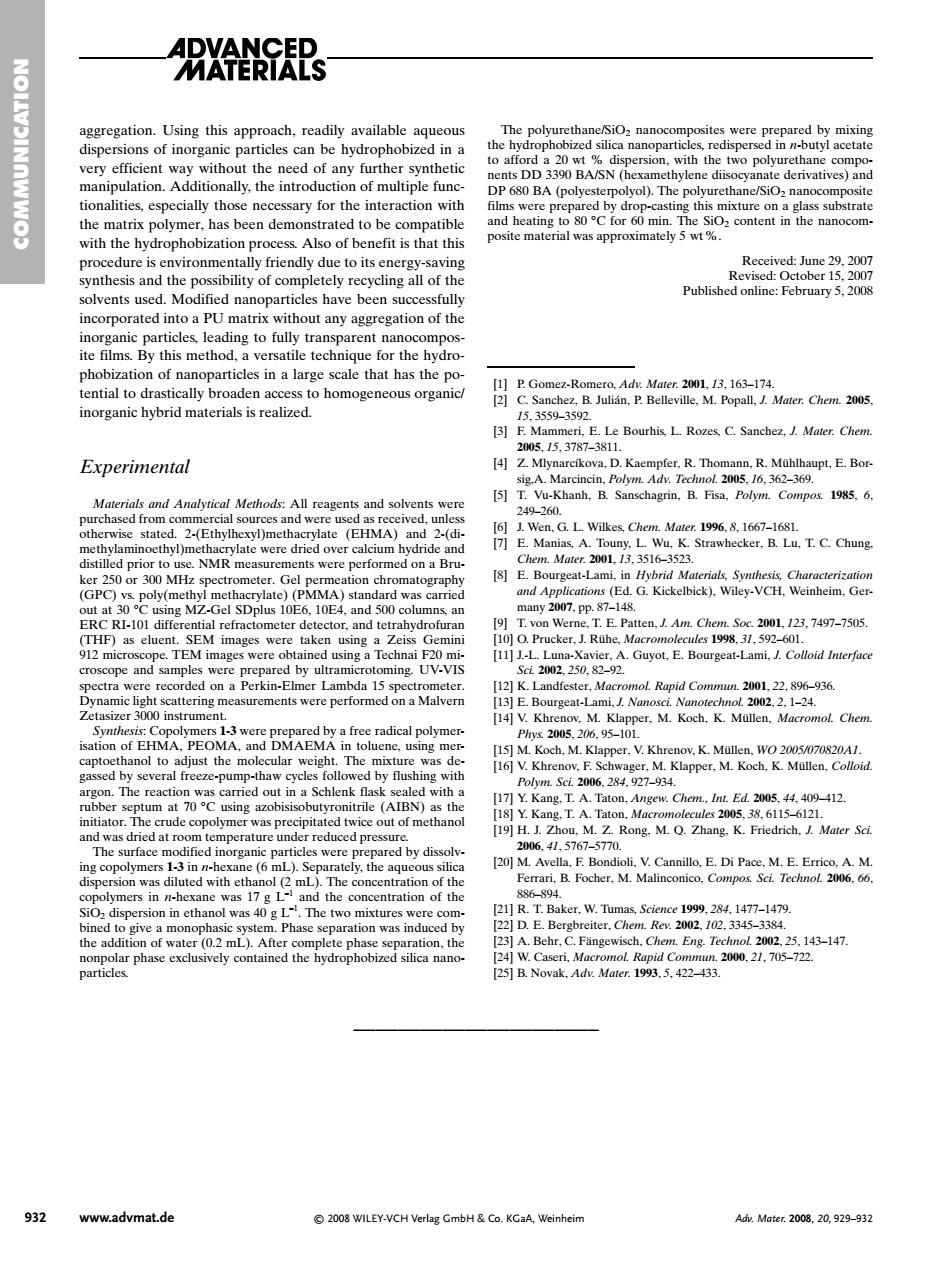正在加载图片...

NO AERTAIS The prepared tionalities.especially those necessary for the interaction with e p ss substrate olvents used.Modified nanoparticles have been successfully ite films.By this method.a versatile technique for the hydro Experimental ,及E.Bo wis statc Mater.196167-68 -12001./3 .T.C.Chung 图EB Ma trome and A Kie-VCH..G RI-10 nd 500 columns,ar sing a Tech ared h ing UV.VIS rgeat-Lami M.Koch.K.Mullen.Macro ure was d using azobisisobuty itrile (AIBN)as the [17 Y.Kang.T.A.Taton,Angew.Chem.Int Rong.M.Q.Zhang.K.Friedrich,Mater Sel by dis 13 1R.T.Baker.W.Tumas Scicnce 1999.284.1477-1479 Pha ter.Chem. 3345- A Boh C E www.advmat.de 2008 WILEY-VCH Verlag GmbH&Co.KCaA Weinheim Adr.Mater.208,.20929-932aggregation. Using this approach, readily available aqueous dispersions of inorganic particles can be hydrophobized in a very efficient way without the need of any further synthetic manipulation. Additionally, the introduction of multiple functionalities, especially those necessary for the interaction with the matrix polymer, has been demonstrated to be compatible with the hydrophobization process. Also of benefit is that this procedure is environmentally friendly due to its energy-saving synthesis and the possibility of completely recycling all of the solvents used. Modified nanoparticles have been successfully incorporated into a PU matrix without any aggregation of the inorganic particles, leading to fully transparent nanocomposite films. By this method, a versatile technique for the hydrophobization of nanoparticles in a large scale that has the potential to drastically broaden access to homogeneous organic/ inorganic hybrid materials is realized. Experimental Materials and Analytical Methods: All reagents and solvents were purchased from commercial sources and were used as received, unless otherwise stated. 2-(Ethylhexyl)methacrylate (EHMA) and 2-(dimethylaminoethyl)methacrylate were dried over calcium hydride and distilled prior to use. NMR measurements were performed on a Bruker 250 or 300 MHz spectrometer. Gel permeation chromatography (GPC) vs. poly(methyl methacrylate) (PMMA) standard was carried out at 30 °C using MZ-Gel SDplus 10E6, 10E4, and 500 columns, an ERC RI-101 differential refractometer detector, and tetrahydrofuran (THF) as eluent. SEM images were taken using a Zeiss Gemini 912 microscope. TEM images were obtained using a Technai F20 microscope and samples were prepared by ultramicrotoming. UV-VIS spectra were recorded on a Perkin-Elmer Lambda 15 spectrometer. Dynamic light scattering measurements were performed on a Malvern Zetasizer 3000 instrument. Synthesis: Copolymers 1-3 were prepared by a free radical polymerisation of EHMA, PEOMA, and DMAEMA in toluene, using mercaptoethanol to adjust the molecular weight. The mixture was degassed by several freeze-pump-thaw cycles followed by flushing with argon. The reaction was carried out in a Schlenk flask sealed with a rubber septum at 70 °C using azobisisobutyronitrile (AIBN) as the initiator. The crude copolymer was precipitated twice out of methanol and was dried at room temperature under reduced pressure. The surface modified inorganic particles were prepared by dissolving copolymers 1-3 in n-hexane (6 mL). Separately, the aqueous silica dispersion was diluted with ethanol (2 mL). The concentration of the copolymers in n-hexane was 17 g L–1 and the concentration of the SiO2 dispersion in ethanol was 40 g L–1. The two mixtures were combined to give a monophasic system. Phase separation was induced by the addition of water (0.2 mL). After complete phase separation, the nonpolar phase exclusively contained the hydrophobized silica nanoparticles. The polyurethane/SiO2 nanocomposites were prepared by mixing the hydrophobized silica nanoparticles, redispersed in n-butyl acetate to afford a 20 wt % dispersion, with the two polyurethane components DD 3390 BA/SN (hexamethylene diisocyanate derivatives) and DP 680 BA (polyesterpolyol). The polyurethane/SiO2 nanocomposite films were prepared by drop-casting this mixture on a glass substrate and heating to 80 °C for 60 min. The SiO2 content in the nanocomposite material was approximately 5 wt%. Received: June 29, 2007 Revised: October 15, 2007 Published online: February 5, 2008 – [1] P. Gomez-Romero, Adv. Mater. 2001, 13, 163–174. [2] C. Sanchez, B. Julián, P. Belleville, M. Popall, J. Mater. Chem. 2005, 15, 3559–3592. [3] F. Mammeri, E. Le Bourhis, L. Rozes, C. Sanchez, J. Mater. Chem. 2005, 15, 3787–3811. [4] Z. Mlynarcíkova, D. Kaempfer, R. Thomann, R. Mühlhaupt, E. Borsig,A. Marcincin, Polym. Adv. Technol. 2005, 16, 362–369. [5] T. Vu-Khanh, B. Sanschagrin, B. Fisa, Polym. Compos. 1985, 6, 249–260. [6] J. Wen, G. L. Wilkes, Chem. Mater. 1996, 8, 1667–1681. [7] E. Manias, A. Touny, L. Wu, K. Strawhecker, B. Lu, T. C. Chung, Chem. Mater. 2001, 13, 3516–3523. [8] E. Bourgeat-Lami, in Hybrid Materials, Synthesis, Characterization and Applications (Ed. G. Kickelbick), Wiley-VCH, Weinheim, Germany 2007, pp. 87–148. [9] T. von Werne, T. E. Patten, J. Am. Chem. Soc. 2001, 123, 7497–7505. [10] O. Prucker, J. Rühe, Macromolecules 1998, 31, 592–601. [11] J.-L. Luna-Xavier, A. Guyot, E. Bourgeat-Lami, J. Colloid Interface Sci. 2002, 250, 82–92. [12] K. Landfester, Macromol. Rapid Commun. 2001, 22, 896–936. [13] E. Bourgeat-Lami, J. Nanosci. Nanotechnol. 2002, 2, 1–24. [14] V. Khrenov, M. Klapper, M. Koch, K. Müllen, Macromol. Chem. Phys. 2005, 206, 95–101. [15] M. Koch, M. Klapper, V. Khrenov, K. Müllen, WO 2005/070820A1. [16] V. Khrenov, F. Schwager, M. Klapper, M. Koch, K. Müllen, Colloid. Polym. Sci. 2006, 284, 927–934. [17] Y. Kang, T. A. Taton, Angew. Chem., Int. Ed. 2005, 44, 409–412. [18] Y. Kang, T. A. Taton, Macromolecules 2005, 38, 6115–6121. [19] H. J. Zhou, M. Z. Rong, M. Q. Zhang, K. Friedrich, J. Mater Sci. 2006, 41, 5767–5770. [20] M. Avella, F. Bondioli, V. Cannillo, E. Di Pace, M. E. Errico, A. M. Ferrari, B. Focher, M. Malinconico, Compos. Sci. Technol. 2006, 66, 886–894. [21] R. T. Baker, W. Tumas, Science 1999, 284, 1477–1479. [22] D. E. Bergbreiter, Chem. Rev. 2002, 102, 3345–3384. [23] A. Behr, C. Fängewisch, Chem. Eng. Technol. 2002, 25, 143–147. [24] W. Caseri, Macromol. Rapid Commun. 2000, 21, 705–722. [25] B. Novak, Adv. Mater. 1993, 5, 422–433. ______________________ COMMUNICATION 932 www.advmat.de © 2008 WILEY-VCH Verlag GmbH & Co. KGaA, Weinheim Adv. Mater. 2008, 20, 929–932